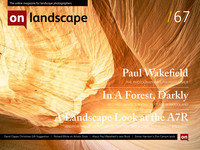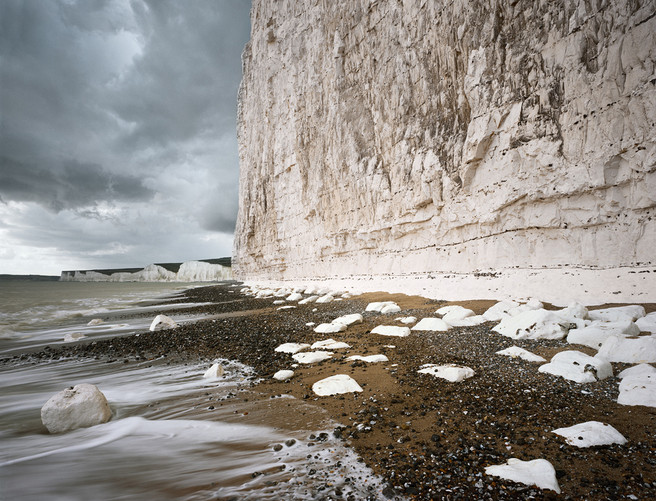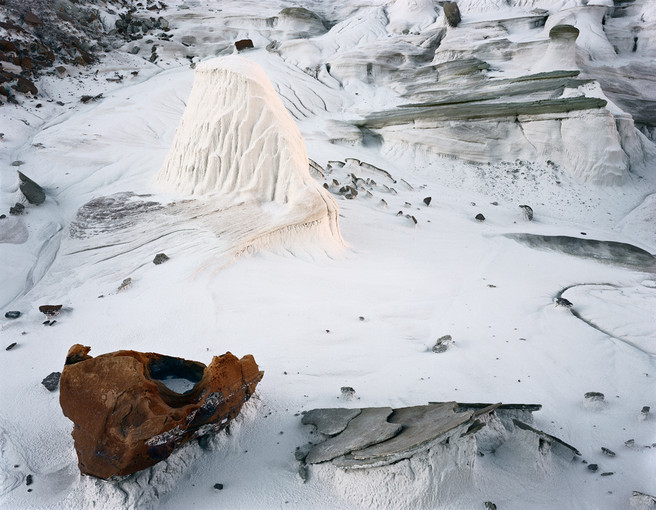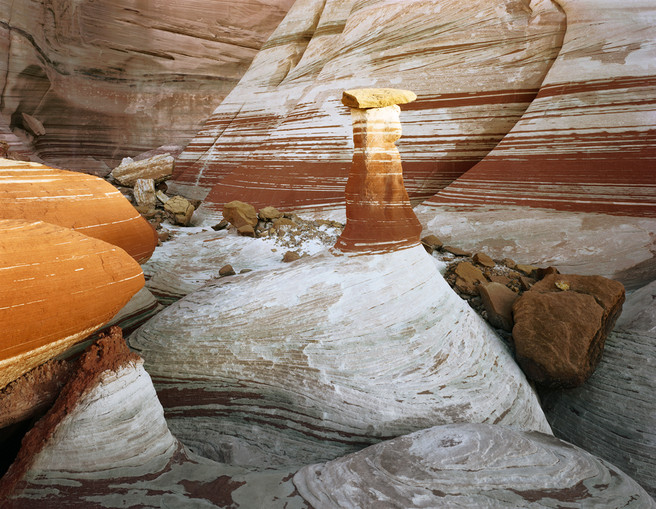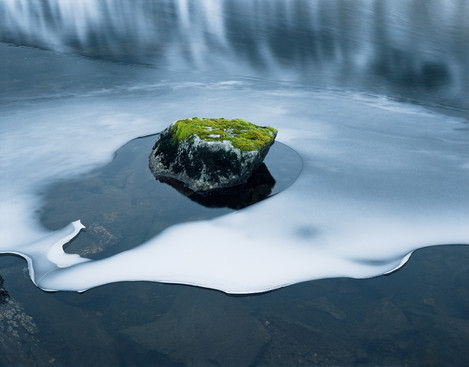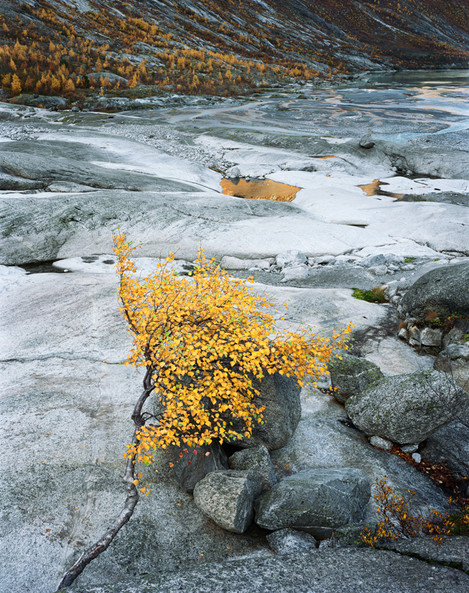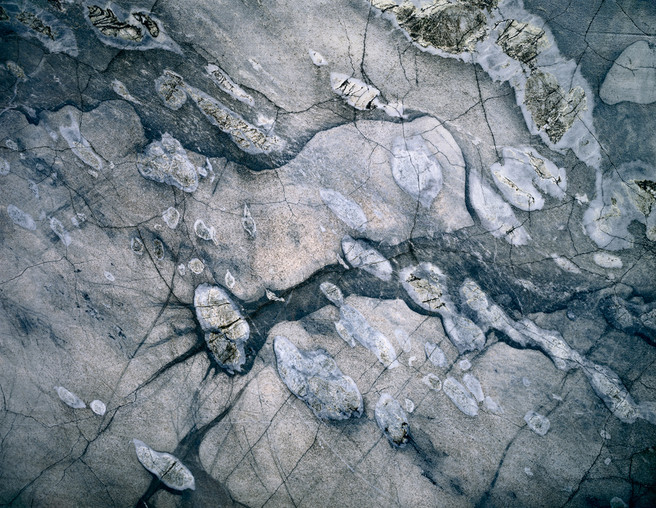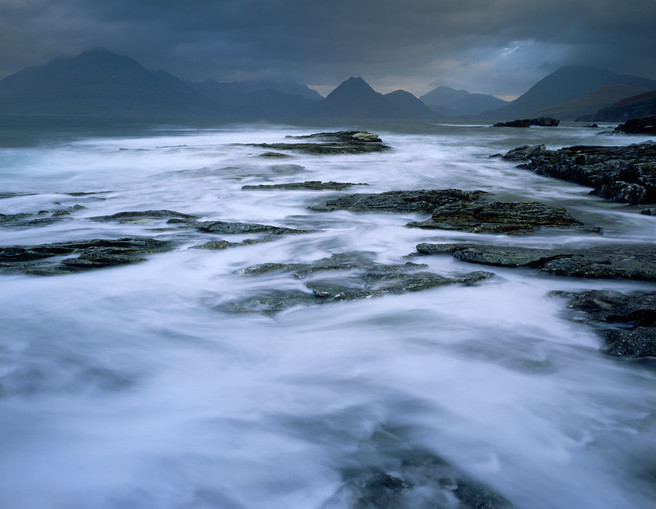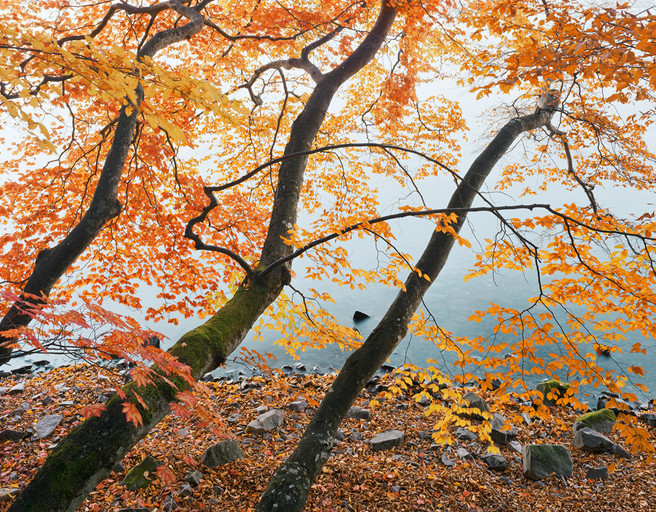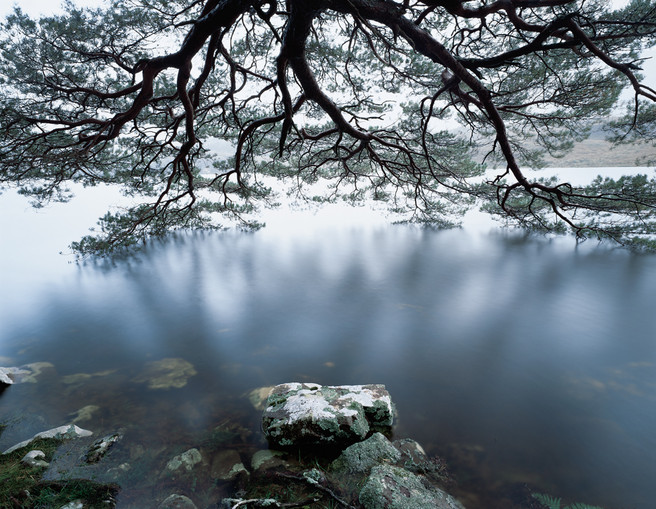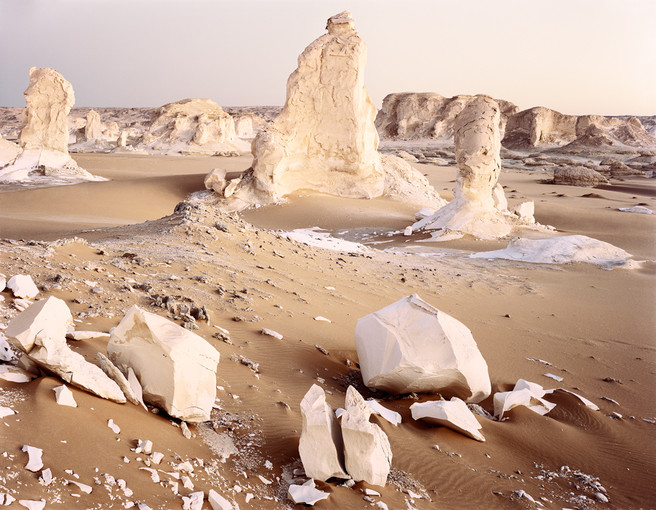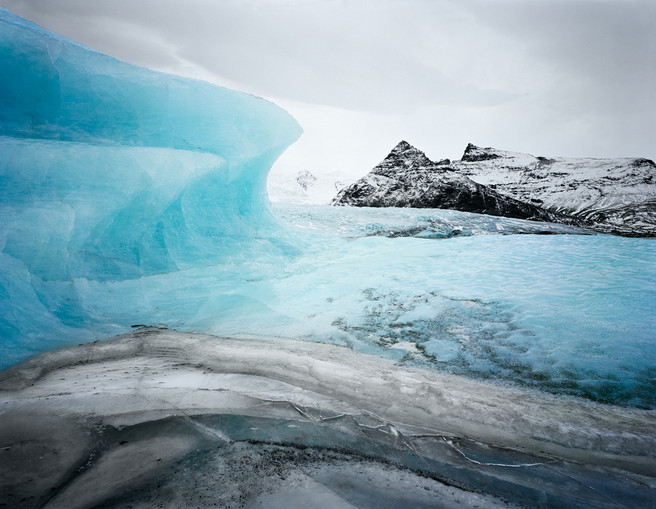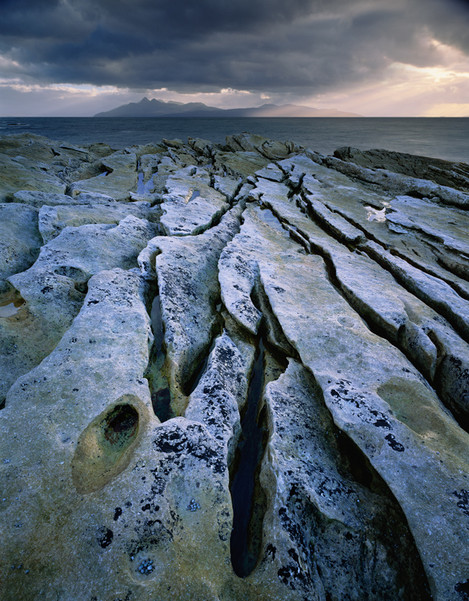A Photographer's Photographer...

Tim Parkin
Amateur Photographer who plays with big cameras and film when in between digital photographs.

Paul Wakefield
He has photographed the landscape of many countries throughout his working life both on assignment and for his personal projects, but returns often to a few locations that are key to his vision.
Some of you may not have heard of Paul Wakefield - he isn’t famous for leading workshops, he doesn’t write for popular photographic magazines and his last published book was in the 1980s. This lack of notoriety isn’t a symptom of a second rank photographer though - in many ways Paul has concentrated on his time on his professional and personal work and has built a career working specialising in naturally lit landscape photography commissions working for many international blue chip clients. His landscape photography came first though and he continues to spend time returning to locations visited on commissions to add to his portfolio. If you’ve got a few of Paul Wakefield’s early books you’ll agree that although the photography is superb and the writing inspirational the reproduction hasn’t been that great. This couldn’t be further from the truth for his new book and we visited his South London home to for an extensive discussion about where he started in photography, how he produced the work he has and finished talking about the new book simply titled The Landscape that I had a chance for a first preview of when Paul produced a set of unbound folios hot from the printing press in Italy the week before. Paul has rarely had interviews and we’ve taken the opportunity to reproduce our conversation virtually unabridged - we hope you enjoy reading as much as I did chatting with Paul.
Could you give us some background on how you originally got into photography?
The first photographs that I ever took were probably when I was about 10 or 12 in Hong Kong with my father’s Zeiss Contaflex. He was quite a keen snapper and quite a keen gadget freak so he had lots of very unusual cameras like Gami’s, almost a miniature spy camera, and things like that. I was also very interested in wildlife and we had a troupe of monkeys down the road that we went to photograph because I used to watch them with a pair of binoculars, so I thought I can just take a photograph of them. But when I got the Kodachrome slides back in the post, as they were back then, there was nothing on them at all because of course, I didn’t know how to operate a camera - I just thought you looked at it and pressed the button and my dad gave me a quick lesson. Yes, there were trees and things in the pictures but it was all a blur and there were no monkeys, so that was kind of intriguing and disappointing at the same time. I thought I’d better find a captive subject and went to the botanical gardens in Hong Kong and photographed the birds in the cages but then I had problems with the cage getting in the way and it’s much darker. So the result of that was equally as bad and so I put it all aside - I wouldn’t say I lost interest exactly because it still really intrigued me why it seemed such a straightforward bit of equipment could be so tricky to use. But then if you’ve got no instruction I suppose any equipment is tricky to use.
I used to look at the National Geographic magazine and was very keen on outdoor walking and went to the New Territories with my father regularly. I used to collect butterflies - all of those kinds of ‘boy’ things - which I wouldn’t do now and when I went to boarding school in England with my twin brother when I was 14 they had various magazines in the school library but it was “Life” that I was particularly interested in. 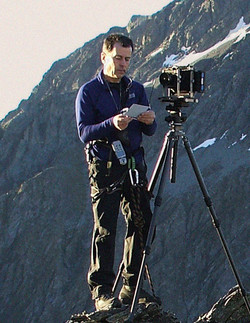 I used to wait for the next issue to come out and it would all be people like Eugene Smith doing his photo essays on the village doctor for instance, which were absolutely amazing. Really in depth observation of an everyday instance which you wouldn’t have the chance to see because it was a documentary of a job. And that was interesting, the fact that you were seeing something of how other people operated that you wouldn’t normally have the opportunity. The intensity of the images was very, very powerful and the emotion was there; you felt as though you were being involved in a documentary through still images. I used to love those and there was also the Minamata disease series (a photo essay by Eugene Smith on mercury poisoning) that I looked at. I was actually looking at photo essays before I remotely got interested in the landscape but I wasn’t actually taking any photographs because I didn’t have a camera.
I used to wait for the next issue to come out and it would all be people like Eugene Smith doing his photo essays on the village doctor for instance, which were absolutely amazing. Really in depth observation of an everyday instance which you wouldn’t have the chance to see because it was a documentary of a job. And that was interesting, the fact that you were seeing something of how other people operated that you wouldn’t normally have the opportunity. The intensity of the images was very, very powerful and the emotion was there; you felt as though you were being involved in a documentary through still images. I used to love those and there was also the Minamata disease series (a photo essay by Eugene Smith on mercury poisoning) that I looked at. I was actually looking at photo essays before I remotely got interested in the landscape but I wasn’t actually taking any photographs because I didn’t have a camera.
While I was at boarding school I went through the process of doing sciences, biology, geography and zoology and then - I don’t know why - at the end of that whole process of A Levels I decided that I was going to be a diver, my brother and I had dived and we had all of the equipment, the compressor, the tanks, etc. I thought I’d be a marine biologist or something because I knew I would never be in an office or a lab but I thought it might be nice to be a marine biologist. And then I really don’t know why at all but I literally one day did a 180 degree turn and went to art college on a foundation course in Bournemouth where my parents had settled on moving back from Hong Kong.
When you’re sent away to boarding school your independence starts quite early and it can be a good or bad thing but going back to home for that year foundation course was a little bit of a struggle even though I had a very good relationship with my parents. I’d had a level of independence that I suddenly seemed to lose - anyhow I stayed there because it was a good foundation course and it had a very good art history teacher, a guy called Michael Gough. I found art history really interesting, not having been taught that before, and learning all about people like Francis Towne and Caspar David Friedrich and then my whole interest in landscape started to come back because I went to art college wanting to do photography, which is why I did the foundation course - at that time you had to, but I didn’t really know what type of photography I wanted to do. I was looking at painting a lot but I can’t paint - I can draw, I’m quite a good copyist if something is in front of me - but I didn’t have a style of drawing apart from what I picked up from people like Francis Towne. I used to draw in very definite lines and shapes as far as landscape goes. I liked the way that he had a minimal colour pallet - at least he did then, what it was like originally I don’t know because it was so long ago - what I didn’t like about him was that he flattened everything off like a telephoto lens, which I don’t like. I don’t like using long lenses - I never do - because I don’t think it gives you a realistic impression of being in the landscape. How can you see with a telephoto lens, it’s impossible. The way he was structuring his watercolours and the way that he had flat panels and minimalistic approach I found really interesting; the same with Caspar David Friedrich really.
You were taught painting and drawing in the foundation course you did then?
No you weren’t really taught anything actually. That was the great thing about it. You were just given these projects and you could do it any way you wanted to. And I did collage, I did drawing, I did a little bit of photography - crap, I think I borrowed by father’s Zeiss again which he still had, I think he probably gave it to me - but I wasn’t really doing landscapes. But then I started to look at people like Ansel Adams, I guess, and Edward Weston, who I actually prefer because he is a little more subtle in his approach. Ansel Adams goes for the big moment but Edward Weston goes for reality more and when it’s black and white it’s kind of a difficult thing to describe because you’re already dealing with unreality. But what I found about Edward Weston’s photographs that I didn’t find about Ansel Adams was that I could look at Edward Weston’s photographs and see them as a colour photograph but I can’t do that with Ansel Adams because the black and white is too strong. It’s all very exaggerated, in a fine way but not in the way that my imagination worked from looking at all of the past documentary black and white work I had been seeing. And also I liked the subtlety of the colour work of the painters I had been looking at.
I then went on to do a three year course and that had to be away from home so I didn’t even apply to Bournemouth. I went to Birmingham, which was not a very good course but again there wasn’t a huge amount of instruction but because I had a fairly strong independent streak I was quite happy to learn on my own and also with others - we formed a little group of about five people on our course and we sort of supported each other and encouraged each other because actually the quality and level of the lecturers at the college was pretty poor - the technical side was OK, which is where I first learned to use a 4x5 camera. We used to organise mini-trips, we used to hire a cottage and go up to Scotland - we just did it on our own and the college was fine with it. They said “What are you going to do?”, we showed them our own projects and they said fine. It was quite good that they allowed us that freedom.
A lot of people have said about art college that an important aspect is the ability to learn from your peers and to develop under your own steam.
Yes, and I never worked well under instruction - I hated the classroom, loathed it - so I’m quite good at thinking on my own and coming to my own conclusions. For some people it didn’t work so well - some struggled and fell by the wayside because they weren’t being instructed enough.
So what were the rest of the people in your group doing, were they photographers?
It was a three year photography course so they were all photographers but completely different stuff.
And what projects were you doing?
I can’t remember to be honest - I did just about enough to get the diploma, which never really interested me to be honest and nobody has ever asked to see it. I started freelancing from college and I moved down to London after two years and I commuted to Birmingham four days a week with a colleague.
You worked in Birmingham or finishing the course?
I was doing enough of the course to get myself by and I was getting jobs in London with my friend.
When was this?
Mid 70s. We would get jobs from publishers, from design groups. And when we got a job we did it literally in our flat. We had one huge room in our big victorian house that was the studio and when he or I had a job we would assist each other. So neither of us ever actually assisted anyone else so we never picked up any good or bad habits and we just learned by trial and error - you could do that in those days as the art director never ever came to that kind of a job so if it didn’t work out you had a certain amount of time, you read the book and came up with the idea and went in with a sketch. Then the art director would say “Yes, fine” and you’d get on with it.
What sort of jobs were these?
Book covers, record covers, bits of design work. Great learning curve. All studio. So there I was back in an office if you like but it was a very good learning process and I did that for quite a long time.
Do you think that was a heyday for photographers in a way because the colour publishing industry had just taken off?
Yes, it was because you could literally walk into an art directors office and you could come out with three jobs. Now they won’t even see you. That was only like that for a few years and then I found it wasn’t fulfilling enough. I also started doing more complicated jobs, record covers with the design groups and things like that. My technical proficiency was at a level where I could cope with a lot of things with lighting but also with natural lighting because when I was at college I was taking a lot of landscapes so I learned quite a lot about natural light. And also while I was at college I was also looking at a lot of photographic books; not just landscapes but all sorts of photographic books. Mostly to do with natural light and I was deconstructing everything as a form of education; trying to find out why they worked and why they didn’t work and why this one did and this one didn’t. I suppose I picked up a lot of preferences during that period about how I saw the use of natural light.
Were you working in black and white then?
No, it was all colour. I was doing some black and white, all of my 35mm stuff was black and white, but all of the 4x5 stuff, as soon as I started using that it was in colour negative and I was processing it myself at college because they had the facilities.
From looking at all of that it was a personal learning process, a filtering process about how I find it more my way of using natural light. In my old books, you’ll see photographs in direct sunlight but I’ve filtered all of that stuff out - even more now and I don’t think there is anything in the new book in direct sunlight. A little bit maybe, one or two in soft direct sunlight, but it’s all in diffuse light. That’s just a preferential thing, it’s just how I prefer to look at things. It’s a much more subtle form of lighting.
Do you think some of that is learned from doing studio lighting work?
I think it probably was yes. I don’t know in what way particularly, I wouldn’t be able to put my finger on it.
Presumably, you were using softboxes in the studio?
Yes I was always using softboxes in the studio, in fact much later on when I got into advertising I had a studio in Charterhouse Square which we bought with a group of people - all artists and designers - which we bought from a liquidator and by then I was doing no studio work at all but it was such a good deal I bought the space. I shared it with two advertising still life photographers and one guy, Kevin Summers who was a very good still life photographer, was designing his own softboxes and getting Strobe to make them for him - no one could figure out what he was doing and what he was doing was not buying standard equipment and his work had a particular look. He was being very careful about how he worked in the studio and he found, like what I was saying to you earlier, about the subtle layers of things that you were only able to achieve by really going into depth into something. If devising your own form of lighting system gives a completely different feel then most people who haven’t done that can’t figure it out. There’s no trick involved, it’s not a gimmick. It’s an intention and a subtlety that your eye has found from experience. So I learned a lot from watching people like that even though I wasn’t photographing in the studio.
So how did you go from your freelance work with your colleague to start doing outdoor commissions?
While I was doing my commercial work in the studio I wasn’t getting the fix I needed from photography and that fix was landscape and so I actually started doing my own work in the landscape after about three years or so after leaving college. I had a Linhof, in the studio I had a Sinar. So I took the Linhof and I thought where can I go? So I thought “Wales. I’ve never been there” so I went to Wales. Started going and it was just fantastic, I’d go there every spare moment I had. Weekends, weeks I wasn’t working, I’d just take off and I’d stay in a hotel or B&B somewhere and I’d walk and walk and walk and take photographs. Just anywhere, pick a place. There was no internet to do research and not many books on Wales. I bought all of the Ordnance Survey maps, I’m a good map reader and can read them visually and kind of imagine what they’re like. But I’m not into pre-visualising somewhere. Even now I don’t do that, I know where I’m going, I know what it looks like but I don’t pre-visualise what I want out of it. How can you? How can you imagine what it’s going to look like under a certain natural light that you’ve never seen before in your life? You can’t! So I don’t do pre-visualisation and I’ve never really understood it. I think about it. I think about how the landscape looks before I go there.
So it’s about possibilities?
Yeah but it’s not forcing a process of thought onto the landscape. It’s more an anticipation, an excitement about what you might find. The uncertainty of it. That’s the thing about film that digital just doesn’t do for me and that is the uncertainty. I like not knowing what I’ve got on that sheet of film in the darkslide. I know 70% maybe what I’ve got but the other 30%.. I might have made a mistake - I don’t mean technically - a decision, a compositional. I make mistakes all the time. But I don’t want to know about them at the time. I want that uncertainty, I want that risk. That’s how I learnt. I went to Wales and I’d come back disappointed that that didn’t work so I’ll try it this way OK. So what I was learning was to look at things very, very carefully before I took the photograph. With dark slides, you can maybe take 10 images a day; although I’ve never taken 10 good images in a day. That’s a lot of images to take. The chance of seeing 10 decent things to photograph! But you might take one or two.
So you’d just go for a walk and see what happens?
Yes. I’d plan where I was going - up here, that lake, this river. I’d either spend the whole day up there or I’d know it wasn’t working and go somewhere else. Depending on the light, again I do not - I know some people might throw their hands up in horror nowadays with the internet available - I do not look at the websites which tell you where the sun comes up and goes down and plan this and plan that and be there at this exact moment. Again, it takes the opportunity out of it for me. The opportunity that something might happen that I can’t preempt. I find that exciting about the photography itself, not just the taking of the photographs - the uncertainty.
Was that what you enjoyed about going to Wales - the walking and the looking?
Yes, I’d walked as a kid with my dad in the landscape and I’m not a great walker for no reason. So the duality of walking and the photography, and doing it on your own, creates a certain atmosphere that … It’s a difficult thing to put into words because I work very intuitively and for me to do too much planning and plotting gives it rigidity and a structure that doesn’t allow my observation to be surprised and that is a real essential for me when I’m looking for things because it’s that actual sense of wonder that I’m trying to convey really.
It is a large part of your photography - the intrigue of the subjects or compositions?
But the subject is incidental isn’t it. I mean look at that - it’s a bit of frozen ice in Wales with a rock in the middle. It happens everywhere, all over the place at any time but when you find the right thing in the right place in the right light and you put yourself in the right position and you use the right camera, lens, blah blah blah. You can get something out of it that you saw with your eye as you were walking and stopped, you can convey that message to other people hopefully and there are certain ways of doing that. It’s a long process of learning.
After I’d done a lot of this earlier work in the studio with record covers and still lives etc. It got a bit boring and I thought I needed a further challenge and so I went to see an art director in an advertising agency, Alan Waldie, a very, very good art director. I took along my commercial portfolio which is all my studio work and some portraits and things like that and record covers. Sort of surreal but all quite well done. In those days your portfolio was all beautifully mounted 10x8 transparencies duped from 5x4 file. Beautiful curved mounts with your name embossed in the front .. and he was just flipping through the work and tossing it to one side and I thought “Oh shit - that’s not good is it!” and then he stopped at the landscapes at the back and he had a really, really good look at them - and he really looked at them - and he said “If you want to move on, if you want to do something different, throw all the commercial work out and just show people this. Have you got more of this?” and I said “Yes” because I’d been going back and forth to Wales quite a lot. “Well that’s what you want to do” he said, but I said, “Yes but where are the jobs, I’ve got to make a living” and he opened up his plans chest and he showed me all these jobs that he’d been doing with commercial photographers like John Claridge and Max Forsyth for the India Tourist Board, Cars, all in natural light in the natural landscape. “You can do this” he said. And of course, that was a complete revelation, we had a little chat about it and he said if that’s what you want to do it’s risky and challenging; you can’t make mistakes but then I’d already made my mistakes already in the studio with my friend. He gave me a list of agents and I got a good agent and I started getting work. The first job I got was photographing Range Rovers and I’d never photographed a car before, in my life - I was completely freaked out. The art director saw exactly what Alan saw in my work and he said it would be no problem; I’ll give you a Range Rover for a weekend - take it out into the countryside and photograph it. He said “You’ll find that it will light itself” and I didn’t quite know what he meant but I did it and he was absolutely right. I put it in the landscape in a situation and in a source of light that was my choice and temperament and it did light itself. It was a soft light, not hard, you can’t photograph cars in hard light. And so I took the Range Rover back, took the sheets of film in and he said “There you are!” and so off we went to the United Arab Emirates and did the campaign - it was great!
That led onto all sorts of work. I did lots of cars, running shoes, alcoholic drinks - I didn’t do cigarettes, I refused, and I refused a Nuclear Fuels job once. So I thought about what I was doing to a certain extent - I drove a car so I couldn’t say I wouldn’t photograph cars. But it was all really, really enjoyable. It wasn’t just the photography that was enjoyable though, it was the whole group dynamic because I had spent my time on my personal work completely on my own - I never go with anybody and I won’t because I can’t get into the right mindset if I do because there is always somebody there not allowing me to focus. With a brief or project though a team of people have been brought together and everyone has their job and their space. Once you get given a job from an ad agency the whole thing is your responsibility and so you can’t f*** up basically.
Talk me through a typical job? Tell me who is involved.
Well, it could be anybody. There will always be an assistant, at least one. There is always going to be an art director, there’s always going to be a producer. So you are going to have a minimum of three other people on any job however complicated or simple. And then on top of that, you normally have another assistant that you would get in the country you are going to. You would have an art buyer whose job it is to take care of the client, so there are another two people. If it’s a car job you’re going to have the people that bring the car, car prep guys - you’re not allowed to touch the car - in America, you cannot do a single thing that’s not your job. Even though the whole thing is my responsibility if I pick up a rag to try and quickly wipe down something I see it’s a big no-no. You don’t do that - you say “John, there’s a spot on the car, can you get rid of it”.
Is that a big unionised thing?
It is a big unionised thing but it’s also a bit of an insult. As if you’re saying “You’ve not done your job properly so I have to go in myself” and I’ve made that mistake and I didn’t do it for that reason. I did it because there was an instant moment of light and it had to be done - I saw this mark and the quickest thing was for me to do it, not to ask John who was sitting over there. By the time he’d have done it the moment would have been gone. It caused such a problem. So you learn - you make sure that John isn’t sitting over there, he’s standing here right next to me. Lots of little things that you learn.
So you’ve got the art director, producer and art buyer - what are they doing?
The producer is doing all of the organisation stuff for you. Food, hotels, location finders, making sure that all I have to concentrate on is what’s in front of me with the camera. I don’t have to think about where dinner is going to be in the evening, is the model coming in time, etc, etc. Like a film producer - very important. It’s a fantastic group dynamic and you normally have a wonderful time and things go wrong continually and that’s also very enjoyable because you have to think about how to get out of it. I don’t mean they go wrong because they made a mistake, I mean they go wrong because you can’t preempt things. In America for example, when I first started doing cars I would just turn up with my camera and my assistants. The art director would say “Where is your lighting truck?” and I’d say “What do you mean - what do you want?” “You’ve got to have a lighting truck!” and I’d say “I haven’t got one”. It freaked them out, to begin with because most Americans, not all, but most American photographers at that time had massive lighting trucks and would build a whole set outside. I mean what is the point of going outside and then lighting everything artificially? And it’s because the American industry came very much from the film industry and so a lot of them were using exactly what they’d use on films. Huge great sheets of bounced light. The only time I’ve ever lit anything on a car job or any other job was if it was at night and you were simulating artificial lighting, street lighting or whatever, so of course, you light it. But if it’s a natural light job you got there at 4:30 in the morning, you’ve got everything in position and at 5:30 in the morning when the light starts coming up - ping! 100% focus, 100% observation. By then you have to have everything dead right and it’s done in 10 minutes.
And in these advertising jobs, they want the golden light?
They do generally. Specifically for cars yes because in that early morning light and late evening light the light wraps itself around the car like a parcel and presents itself to you, almost with a bow on top. It’s a little bit of a wow moment, you’ve done nothing, you’ve chosen a spot for the car to be. In an example like that where I said earlier that I wouldn’t use information about where the sun is coming from, obviously on a commercial job it’s 100% about that and when my scout does my recce for me he has to take compass readings at every single location and he also photographs what’s behind him. I want a 360 degree coverage. And if there is a hill behind me - is it going to reflect in the car, all of that. Everything is completely covered so I know exactly what it’s going to be like when I’m there. I have to do that because it’s commercial and I have to cover all of my bases. You’re still in that moment of uncertainty but I can’t get to a location and find out that it doesn’t work and the art director says “Why didn’t you know about this?”.
With a lot of car adverts now they seem to be computer generated now. Do you do work for the CGI people at all?
No, it’s either the whole thing or not. I sell some images through Gallery Stock through the American photographic library which I was at the instigation of because it was partly started by my American agent and they still have some of my stock. If somebody came to me with a car job though I would want to do the whole thing.
Are you still doing car work?
Nearly everything now is CGI, the car was never there. The landscape was photographed as a digital 360 capture and sucked onto the digital diagrams. Light wrapped around the car just like I was telling you about - they now do that on computer. But you can tell - if you’ve done this work yourself. You can see a CGI image a mile off. And it’s lost something because of that. But that’s OK it’s a commercial process and it’s a lot cheaper and it looks good but it irons out all of the imperfections and they can’t get rubber right. You can tell by the tyres.
From your work doing commercial landscape, how did you mix that with your personal work?
Well I had taken all these photographs of Wales over a number of years and there came a point where I thought I’ve got to do something with them, I haven’t just taken them for myself. I thought I would do a book so I looked into getting them published and Helen said what about getting a writer? So we had a list and Jan Morris was at the top and she was THE Welsh writer at the time and a brilliant writer at that. So I rang her up one day and said what I was doing and could I show her something to see if she would be interested in writing and she said yes, that sounds interesting - come see me when you’re next in Wales. I said I was coming the next weekend, which I wasn’t then but I suddenly decided to. She was fantastic and she said yes on the spot. I showed her 4x5 transparencies, which will have been something she will never have seen and I took a lovely little mini lightbox and a 4x5 frame and just put them on the lightbox and they just glowed in her living room. I think that is one of the things that sold it to her, it brought them to life in her living room and she was completely amazed at seeing this shiny, glowing image when she was normally used to looking at flat printed images. They have their own unique moment
So then I had to find a publisher, which wasn’t too difficult with a name like Jan Morris. So we managed to get Aurum.
So she had been published photographic books before?
No always just written books. I did a trade with her. She was actually at the time writing a huge book on Wales called “The Matter of Wales” and because it was a bit tricky with the publisher where they were offering her some derisory amount of money and she had got insulted by that, quite rightly so, and I could see the whole thing collapsing so I rang her up and said “You’re doing this book, why don’t we do a swap - have you thought of doing some photographs for your book - I’ll photograph specific places you want me to photograph in black and white and I’ll do those for free if you do the writing for free and she said “good idea!” and that’s how it worked. And then that book went very well and got reprinted twice and into softback. And then of course they decided to treat her properly as they should and I got sponsorship for the next two books. I rang Shell up and they gave me money to cover the expenses basically and then for Ireland I went to the Allied Irish Bank.
So Shell sponsored the Scotland and Britain books?
Yes, I went to them because they had got a tradition of doing the Shell guides which I had always loved and I do remember looking at them and I loved the illustrations in the English ones - I think his name was Tristram Hillier and he did these lovely still life paintings of rocks and wasps and things. I’m always collecting something - when I was a kid it was butterflies, bird eggs, it was stamps, orange wrappers, zuni fetishes. And photographs are a collected memory really.
When were Ireland and Scotland photographed?
In the 80’s. So after I’d done the Wales book Aurum thought it was good and said to keep going. I was keen as well and they still wanted me to carry one. But what happened was that it became a brief. My personal work became a brief - a commission. It turned into a job and I refused to do it anymore. It was probably a mistake but, you know, I live by my decisions and I don’t regret anything. I got heavily into commercial work which I loved because of the whole organisational thing and the group dynamic. It was a fantastic way of life and good money. A lot of travel. Went to a lot of places, saw a lot of things, met a lot of people. Good fun.
There are a lot of places represented in your new book. When you were doing these commercial jobs were you photographing your personal work when you were out on location or extending your trips?
No you can’t stay out afterwards because you have to process the film, get it to the agency, overlook the job, etc, etc. But yes I’d find out about places because I’ve photographed a car in this place or that place and I’d think “Wow, this is an amazing area. I’ll look into this!”. But when you say there are a lot of places in the book, there are but when you cut it down there aren’t actually that many and I’m using places as an example. The desert images for example are in just two places, they’re either in Egypt or in the mid-west states - the four corners area of America. That’s it. You could have gone to the Gobi, here, there, etc but I just stuck to those two and interestingly I found similar things going on in both places which I found fascinating. However many thousands of miles apart but the same things were happening because of the conditions.
So you would go back to these locations once you’ve found them or heard about them. You’d make your own personal trip out there for a week or two weeks.
More like three or four weeks to be honest and then I’d go back again and again. I’d become interested in particular areas and I find that I can get more out of somewhere the more I learn about it than just by going to somewhere new. I’ll never learn enough about a landscape because it can never, ever be the same and yet I've got to find a way of not repeating myself just because it's a different kind of light. Whether I have or not is down to other people to decide. I think I have because I know how I've moved on over the years but it's subtle. I work very traditionally, I don't have gimmicks or any specific rules of composition that I adhere to but obviously it's there in my work. But I don't go thinking I've got to do this, this, this and this; I'll react instinctively to something when I get there. Yes of course I'm going to look at it in my own way because I'm me and I won't look at it like someone else does and so there are bound to be stylistic elements that go throughout the work. That's what makes someone's interpretation of the way they might photograph or draw or paint something individualistic.
In terms of when you're working in a location, how do you approach an area?
Open minded is how I approach it. I can't deny, obviously, that subconsciously there are things going on but I don't seek to analyse it because I would lose some form of spontaneity if I analyse something too much. It is a very subtle thing and if I try to force something it is going to look forced. I just let intuition and my natural feeling of observation take care of itself, I trust that.
You mention that you don’t particularly like long lenses…
And I don’t like hugely wide angle lenses. I would be happy to use a 120mm lens on a 4x5 camera.
So most shots are standard to slightly wide
I hardly use a 150mm lens. I have in the past used a 210mm - very rarely - I think I still have it. I don't think I get rid of anything on the whole. I would say I use 120mm. If you want the technicalities - I use a 120, I sometimes use a 90 and I very rarely use a 72. If I'm in a situation where I can't go back any further and I want to see what I've got. But not for perspective and certainly not for distortion, and if you use these lenses carefully they won't distort. You will get natural perspective. And the 120 I like particularly because it has a sense of peripheral vision.
So the camera you've used mostly through your career is the Linhof?
No it's the Ebony - I've used the Linhof as well though. I can't remember when the Ebony's were made - I bought them when they came out in around early 2000. Mainly because it did what a Sinar and a Linhof did in one camera and it was much quicker to use and a little bit lighter. And you didn't have to flap the bed down - all sorts of boring rubbish. It's also a very, very strong camera.
Some of the images in the book are also taken with a 617 Fuji and I did have a Linhof but at the time Linhof only made it with the 90 fixed lens and I wanted to try two lenses but I only ever used one on the whole. But I hardly ever used that camera. I hardly ever have it with me but I'll take it somewhere if I think that type of landscape might suit that format. And I'll only use it if there is something about the form of landscape that works very well in that panoramic - I don't like the word panoramic because it has this feeling of this sort of 'sweep' and I don't use it because of that. Do you know Ivon Hitchens' work? He's an English painter in the 30's to 60's - he's a landscape painter but sort of abstracted but not to an extent that you can't tell what is going on and I absolutely love his colour sense. But he also did this format which is why I tried it out but I found out very quickly that it only worked when you use it for the right thing. For example this shot here works particularly well.
The whole point of this is the two end points. I can’t do that image on a 4x5 because you go down and you get the boring foreground and you go up and you get the sky. It’s not the same thing that you saw and in fact I’ve done a lot of photographs in this place with a 4x5 and I went back specifically to photograph that with my 6x17 - I took it the following year because I knew that photograph was there and I wanted to see if it would work; I knew it would work actually.
Would you say you naturally see in a 4x5 aspect ratio or do you crop pictures?
I tend to see in a 4x5 ratio. The Linhof viewer helps a lot, I use it all of the time before I get the camera out. I can get a camera out and set it up pretty quickly having done it enough times but I don’t really want to get it out if I’m unsure and so the viewer allows me to be a little more sure. And sometimes it works and sometimes it doesn’t. You know the first impression you might get is just this fleeting little thing “Did I see something there? What was it? Let’s have a look.” and of course you shut everything off and look like that. A bit of card will do equally well. In fact, I used to do this - a 5x4 bit of card and you just hold it up. A lot cheaper way than using a Linhof viewer. In fact twice I’ve lost my Linhof viewer over a cliff on a personal trip and I’ve just gone back and bought a bit of card and cut it out and it works, it’s fine.
You were talking earlier about the fact that you don’t want to think about the camera when you are working. Joe asked if you find any difference in working procedure when you are using a digital camera?
I think I can use any camera without it getting too much in the way to be honest with you - particularly if it’s on a tripod. I think it’s a different example if you’re holding a camera in your hand and I think the reason for that is because you would tend to be a bit sloppier with a camera in your hand as your hands are always moving, they’re never still, and so if you have a camera in your hand you are not being critical enough about what you’re looking at. Whereas when you have a viewer in your hand it’s not a camera, it’s a viewing tool, an observational tool and you’re focussing your attention through it and once you get to that point I put the viewing tool on the ground and set my camera up on top of it and click the 5x4 camera onto it and start of by getting exactly what I saw in the viewer. Most of the time that is what I end up with.
So in many ways your camera that you are using to compose with is the viewer, not the camera.
Yes, yes. The camera is just a piece of equipment to record what I saw through my eye and then pinpointed through the viewer. Because the viewer is a small thing and it’s not a camera you use it as an observational tool, a little bit like you might use a pair of binoculars to look at a bird. You don’t roam around once you’ve found the bird - you keep your eye on the bird. Yes, I might move around a little bit but mostly what I’m doing is finding that point of what I felt I saw before I got the viewer out of my pocket. I might move a little to get the right place move the card or change focal length on the viewer to pick a lens but then I’ll put it down.
And when you work on a composition do you work on the corners and edges in or compose instinctively.
I work on the whole thing, the whole picture and it’s partly what you leave out as well as what you leave in that constructs it for you. There is a sort of feeling of intrigue about what is outside of the image that I’m not showing you but that goes on outside the image frame. Another thing I’m trying to do is to make your imagination flow out of the image and place it in its natural setting. It’s a hard thing to describe and one doesn’t want to get into pseuds corner or anything, but they’re not easy things to put into words because I do it naturally and I do it instinctively and the more analysis I do of it the more doubts would creep in “Am I doing the right thing or not?”
I trust my instincts - I genuinely do. I’ve done a lot of street photography in India, which is a complete antidote to this work and I do it on a Leica M6 and a Fuji 6x9 camera on colour negative. It’s just standing, lurking around street corners or markets. Places where I’ve decided that it would be an area that is going to give me possibilities, that things are going to happen in that spot in the future. You can see the juxtaposition of certain things and what has gone through. So I’ll just find a spot and after a little while, even in India, you become invisible. When people have got used to looking at you and you don’t have cameras wrapped around your neck - I’ll just have one in my pocket or something - and they get used to you quite quickly, just getting on with their business. And then when things happen I photograph them.
And it’s the same with the landscape, I don’t force things onto it, I just let things happen. And they will - or they won’t, in which case you just move on.
I was speaking to Charlie Waite at the Landscape Photographer of the Year exhibition and he said he would like to see a book of the India work.
Yeah - it’s an interesting book.
Is there still a possibility of seeing it?
I hope so! I’ve got it in a book form. I had it with a French publisher for about nine months and it came very close to being published. The editor was desperate to do it because she saw the potential in it, but again it became a financial thing. Dewi Lewis nearly did it, it’s not going to disappear.
I notice that one of the things that has changed with your photography is the use of negative film. Nearly everybody who does classic landscape has typically shot transparency, Charlie Waite, Joe Cornish, etc and most contemporary landscape artists have shot negative. You changed from slide to negative for most of your work. Why and what did you see changing because of that?
Really because transparency was always for me a little bit unreal. At the time when I first started I was using daylight Ektachrome 6117 and it was very green in the shadows and it didn’t push well, you couldn't do much at all - the DMax would go completely, it would go grainy - it was an ugly film but there wasn’t anything else basically, it was the only decent emulsion at the time. Fuji wasn’t making anything remotely decent. And then when Velvia came out I started using that because the quality of the emulsion was a lot, lot better and you could control the pushing really, really well.
And you mentioned previously to me that you regularly push your Velvia and you also mentioned that you use a colour meter. Could you tell us a little about that?
Colour film, transparency film in particularly, will pick up everything that the eye doesn’t see. It will pick up natural colour casts and if you are in, to take a simple example, a shaded river valley on a day where your location is getting no direct light, which is the situation I usually work in, but the sky above was not overcast but was bright blue; You would get the lighting conditions you or I wanted in the river valley but not the right colour source - I’d be getting blue light. Because there was no direct light the only light you are getting is overhead light and that is blue because the sky is completely cloudless. If you photographed without finding out what the colour temperature was that the film saw then you are going to end up with extremely blue exposures - very blue, ugly blue. Your eye will see a certain amount of blue - that’s why you see impressionists showing purple shadows and blue shadows, because they had a heightened reality of what the colour temperature was like in those shadows and they weren’t wrong but they were exaggerating it because they were taking painting a step further than it had been taken before. But if you do this photographically it comes out so blue that in my opinion it’s ugly and unusable and so I would use a colour meter to find out what the colour temperature was like by reading the incident colour of the sky above me and it would give you the information in terms of what kind of 81 filter you would have to put on to correct it. I would then decide whether to correct it completely to zero or to leave a certain amount of blue and generally I do like to include a small amount of blue because that is what my eye was seeing. So yes, to use colour transparency for me correctly and successfully I always use a colour meter. You don’t need to use it in open sunshine because if you use a warming filter everything will go orange. But I nearly always worked in soft light so I used the colour meter.
And you also said you nearly always pushed Velvia. What were you trying to achieve by that?
It allowed you to get a little bit more contrast out of it but it also tended to take yellow out of the highlights and generally it gave an extra little amount of cleanliness and clarity.
And you’ll do about half a stop?
I’ll do anything between a third and a stop, depending on how I’ve decided to photograph it in the first place. I would never push film if it was in direct sunlight though - but I don’t do that so. I do it in soft light conditions and Photoshop wasn’t around then - in black and white you had five or six contrast papers but in colour you just had crappy old Cibachrome so you get no choice. So one of the ways you can alter that is by pushing your film, particularly if photographed in soft light. Once you go beyond a stop and a half pushing you will lose quality but in my eyes if you do that you’ve probably made a mistake, calculated the exposure wrongly and you’re trying to save something.
And you started using negative film after a while?
Yes, because even then after a while I found Velvia too over saturated in certain colours, particularly the green and I find green a hard colour anyway and green and red together when they’re saturated on Velvia can be really, really tricky. So I started going back to colour negative which is what I originally used in college and found that that had the subtlety and more of the reality of what I felt I saw and it gave better prints even though c-types are completely fugitive and rubbish - they look better than a Cibachrome because they haven’t got that plastic coating which blocks you off completely and doesn’t let you enter an image, whereas a c-type at least allows you to enter an image but it’s got no longevity - it fades very, very quickly. I wasn’t really doing it to sell prints, I could always print another one. The print was just a tool. In fact when the American school of photographers like Stephen Shore were all using 10x8 colour neg film and they were selling their work to museums and this work would go on touring exhibitions and it might tour for two years and it would come back to the museum and the curator would look at it having not seen it for two years and think “What the hell has happened to that!?”. Of course it had faded by maybe about 20%, and not consistently. And they would go back to the photographers to ask “What is going on here? We’ve bought this piece of work in good faith and it’s fading”. And it’s not fading over a hundred years like a painting might alter and have a natural patina, this was just disappearing and going cyan or magenta or yellow - mostly going cyan though. And in the end what these photographers were having to do was, for the price of one print, they would sell the museum two prints.
So they had a replacement they would put in storage?
One was never ever sent out and was never shown to natural light and the other would go on tour and I think even then that touring image would have to be replaced for no extra cost. It doesn’t cost much to replace though and it would end up with the same number and you’d just cut up the faded one.
So the reproductive qualities for print - and I don’t mean book print - was never ever any good until we got Hahnemuhle paper and digital printing.
So in terms of the book here is it a mix of slide and negatives?
Yes there are three types of film, there is the original Kodak, which there are hardly any of but there are some picture from 1989 - mainly because the image for me works really, really well and I’ve never had a chance to reproduce it in a book form, so it was a great opportunity to do that - and possibly a couple of early 90’s ones; Then there are maybe 30% Velvia and the rest are colour neg. But Photoshop and digital printing allow me to standardise everything.
Yes, you’ve worked the two toward each other so your negs look a little bit more like transparencies and your transparencies more like negs. And the way you expose your negs, do you use grads?
Yes I use grads for the sky.
So you expose your negs in a similar way to your transparencies?
No. On transparency I photograph for the highlights and push and on colour negative I photograph for the shadows, just placing the shadows - and I also push about a stop. I generally push almost everything in neg about a stop and again it does exactly the same, it cleans up the whites. And that’s all I’m looking for really - I’m not looking to do anything odd or exaggerated - but I’ve done tests where I’ve done exactly the same shot and I’ve kept one normal and pushed one and you look at the contact print and every time you’d choose the pushed on; it’s just that little bit cleaner almost like it had a breath of fresh air through it and the normal one doesn’t, it’s just a little bit muddier.
And when you gradding is that to bring the sky down so you don’t have to do much burning in?
Exactly, because I think that although you always have to do a little bit of burning in, if you can do two thirds of it in the camera then you are not going to over egg it. At the same time if you use too strong a grad you are going to ruin it. So I don’t use very strong grads - I use .3’s and .45s and perhaps a .6 now and again when it’s really difficult and there is a major difference. But on the whole because I am using soft light, the landscape is soft, the sky tends to be soft and so .3 just about does it; and often I don’t have to do anything to it. What I see is what I get.
Do you do your own post processing?
I post process everything myself - actually no that isn’t quite true. One of the guys that did a lot of my scans - Patrick Haugen - he is the most brilliant scanner and he worked for the retouching house that I used on commercial jobs, Saddington Baines - probably the best retouchers in the country, and Patrick was their scanner (although they don’t scan anymore because they don’t get any film) and he made most beautiful, painstaking scans that were exactly like my transparencies and then later negatives. And of course I use you too and you’ve very good too. But previously to that I didn’t really want to get into any of the whole Photoshopping thing, all I wanted was Patrick to get exactly what I had on the transparency or exactly what I had on the contact print - but obviously the contact print needs a little bit more interpretation - and so I would sit with him and he would do all of the work. After a while obviously you pick up things about how to do things and he taught me a lot, on commercial jobs I learn a lot because I’m with a retoucher all of the time, you pick up a lot and basically I use Photoshop how I would print in the enlarger. I use the mask tools. Local adjustments, balancing it up, using the grad tool; but a lot of it with the mask drawing tool and softening the edges. It’s a balance thing.
So when you’re doing your post processing you are doing a certain amount of attention shifting around the picture?
Yes. But you know with the contact print there or the transparency there and sometimes I might change it and sometimes I might do it exactly the same you know, I don’t see any reason why I shouldn’t make my own decision at that stage. But it’s very close to the actual thing but there is a certain amount of memory that is involved, remembering how it was when I was actually taking the image. There’s an emotional value in there that I want to include.
And you say that you really want to show what it looked like to you - not necessarily how the camera captured it
Well the camera does capture it pretty closely actually, I’m not actually adding anything that I wasn’t attempting to do at the time with the camera and the equipment that I had.
When it comes to printing now, do you do much printing of your own work?
I do a tiny little bit, I do my own commercial portfolio printing, up to A3+ which is the size of the portfolio, but anything bigger and anything I sell I get a lab to do it from my file and I take my flatted file and I take my own print and they will get as near to that as they can. And amazingly, even though they’re using a big Epson printer and I’m using a small Epson printer, I’m always interested in what they’re having to do to match my print. Generally, it’s not much - usually just moving the centre of the curve up or down a couple of clicks and it might be, because of the screen values, putting one or two points of magenta out of the neutrals or something like that - minimal things.
So you are printing on inkjets and what sort of paper?
Hahnemuhle Photo Rag and I stick to it because I think it’s a great paper, it takes the ink well, it seems to have amazing longevity. I’ve had some thirty or forty prints displayed on a wall for fourteen years and I can take on of my current prints up and put it next to it and it’s exactly the same. I think that’s pretty good. And that is in a room that has got a lot of light, not direct daylight but it’s got windows on both side and it’s a big 25 foot square room with a 10 foot ceiling with white walls and ceiling. I put those pictures in in 1999 and they look exactly the same. I don’t see any reason to change that.
It’s been a while since the Jan Morris books, where did the idea for the new book come about?
Well, I’ve been wanting to do another book for a long, long time. I’ve been wanting to say something, to put together a series of pictures about the landscape that is a much more personal approach to the landscape than just a book about a certain place. The four other books were about certain places and the only certain place about this book is the landscape, which is a very certain thing in of itself but I didn’t want to do anywhere that represented a particular country, I wanted to do something that represented the landscape as a whole on a more inclusive emotional level where the locations weren’t important but the whole narrative was. And that is really all that I’d be happy to say about it because it’s as loose as that and it’s for other people to bring their own interpretation to how they look at it and how they see it.
You mention that you don’t want to talk about why a picture works or what it was about or what you were thinking when you took the picture because it’s about the photographs.
Yes, it works for me and for other people it will work and for some people it won’t work and some people will say that this works but I don’t get that one. But that’s fine, it’s a perfectly reasonable thing to say - it’s a subjective evaluation.
Rather than divide it into locations you’ve divided it into landscape archetypes
I have. Exactly.
We have Shorelines, Rockscapes, Drylands, Woodlands and Snowscapes. And these are more about the feel of the landscape rather than where you are. And apart from a few, they are fairly anonymous.
There are not that many locations there where you could instantly say “I know where that is”. I haven’t done that purposefully necessarily, I haven’t gone out with that purpose, it just so happens that I photograph the landscape in a certain way where it’s what is in front of me that is important and not the location - if that makes any sense. The location with a name is not the important thing it’s what I’m actually looking at. It’s all a matter of observation rather than this is so and so, this is here, this is there, this is Utah, this is Scotland. It’s a generic thing, topographical, traditional.
I would also say that even where you have large views the scene is intimate in nature. They aren’t about the big areas or the big landscape.
It’s not about the wow moment - I hate that expression actually, I shouldn’t use that. Yes it is about intimacy, even with a wide view it’s about the intimacy and if you say that it’s more about how I felt about being there at the same time because it’s an intimate moment. It’s a relationship between my eye and my mind with the landscape and so there is going to be some intimacy there because that is how I see and that is how everybody sees actually. I think people get sidetracked onto going somewhere because it’s been done before and because it’s produced some stunning image. Actually, anywhere can produce a stunning image if you look hard enough and if you observe closely enough. I guess what I might be trying to say is that anywhere in the landscape has its own resonance and has its own power of wonder. You don’t have to go to … where do people go now?
… Iceland’s quite popular?
Yes, Iceland. There is nothing wrong with Iceland, I love Iceland. I think it’s fantastic. But I can only photograph it in the way I feel about it myself. And I don’t think that is about standing on the iconic spot and photographing .. I have got a photograph of Jokulsarlon but I photographed it in 1995 and I hadn’t seen that much stuff about in 1995 of that location. I took my Land Rover over on the ferry. I suppose I’d done a certain amount of research but it was mostly having a look at a couple of books and buying the maps - I bought all of the maps and they are fantastic. They are stunning maps the Icelandic maps.
… and they have a lot of different ones too.
They are very detailed and I looked at those a lot before I went. Was there much internet stuff in 1995?
Not really, not accessible
So yeah it was maps and a couple of books
The Eliot Porter book possibly?
Yes, there was that. Eliot Porter was a wonderful photographer of course. I actually wrote to him and we had a little bit of a correspondence. And I wrote to Ansel Adams. What I get out of going somewhere is my own personal sense of discovery and it’s just as important to me to photograph it as to discover and I don’t really want to look at everyone's photographs of somewhere before I go there because it will give me these ideas about what to expect and I’m going to end up looking for those things “Oh yes I saw this, I wonder where that is. Ooh I should spend time looking for that”. Where there’s all this stuff zooming by you.
Have you been to Iceland a few times?
Yes, I’ve been back a few times. I’ve done some jobs there and actually when I’m on a job I tend not to take any photographs for myself, mainly because my whole responsibility and focus is on the job and even though it’s in the landscape and on many, many jobs I’ve seen things that I would have loved to photograph for my own personal work but I’ve just gone back again. I’m quite happy to go back again. But there are two photographs that I did on a job and that is those two (Fjalsarlon, Iceland - shown below and a New Zealand tree and fern draped river bank) on a job for Aigle, a French clothing manufacturer, and it was the dream job basically. Because they asked me to photograph my personal work.
So these are the same job - one in Iceland and one in New Zealand?
Most of the campaign was in New Zealand. There were five ads in New Zealand and one shot in Iceland. The landscapes were photographed and then we went back to Paris to photograph the people in the studio digitally with a Hasselblad with the right colour background depending on what the retoucher wanted. I discuss commercial jobs with the retouchers all of the time because I can’t necessarily think of all of the things that he might want that would make the job easier. So he’ll ask me to do a few things and I’ll do those. But because I was asked to do a job like that and literally photograph landscapes that I would take myself and because there were no people in them and neither of these were used in the Ads they were almost my personal work. This one is almost identical to another shot we used for the ad, it was just a different part of the river, this one wouldn’t have worked for the ad because it needed a flat sheet of ice with a glacier behind for their layout. I took lots and lots of photographs over two days on a frozen lake in Iceland and then came back.
So when you are in Iceland taking the Jokulsarlon shots and you’re there for four weeks, how many pictures do you end up taking? You mentioned two a day.
Oh no I might take more than that but I might only take two decent ones. I don’t know it can range from none to - I would say I tend not to take more than about 20 sheets of film and I would tend to try to duplicate exposures, mainly for safety. I’ve had a few shots ruined during the process somewhere - mostly in the processing - for it to be incredibly disappointing. If you’ve got a backup shot that’s great. A lot of the time when I’m in a location where the possibilities are endless and you could almost take fifty images a day I’ll only use one sheet of film. On the whole I try to make my decision at the time of taking it rather than editing it and that is what I think is another thing that I suppose maybe makes my work a little different - because I’ve made the decision before I’ve actually taken the shot. I’m not saying I put a lot more thought into it than other people but because I don’t have a digital camera and I can’t take a 100 images and delete ones, I need to make my decision at the time of taking it and it’s actually an incredibly good educational way of improving.
So the situation when the light keeps getting better and you’re wondering when to trip the shutter…
There is that but if I’m in front of something and it’s really stunning and I know it’s stunning, yeah I’ll do maybe six sheets of film. I’ll take one to cover myself and then you look around and you can see from experience that there is a possibility that it might improve. But then you might be wrong but as long as you’ve got the shot. But if it improves dramatically - yeah take another one. But it won’t be many more than four or five. If you haven’t got it by then there’s no point. You could take fifty and they could all have something about them that are equally good but you have to make your decision that that is it.
So when it came to choosing pictures for this book - how do you go about it? You must have a huge amount of pictures to choose from?
Yes, there are. I’m not necessarily saying that these are the eighty best shots, for want of a better description, that I’ve ever taken.
It’s not a Greatest Hits album
No, it’s not - not at all - it’s a narrative and each image has to fit into the whole.
The division into these landscape archetypes…
I tell you what it was, it was a subtractive process. I’ve got a lot that I thought “I’d love that to be in and I’d love that to be in” but they didn’t work within the sequencing.
And you spent quite a lot of time on the sequencing?
Yes, I spent a long, long time on it.
I’m not going to ask you what your plan was but while you were sequencing do you think your reasoning might be something people can relate to or get whilst they are ‘reading’ the book or is it a very personal narrative?
It’s a personal thing and they are going to get whatever they want out of it. The three people who have written pieces in the book - I gave the images to them in a portfolio, in the sequence that they are in with a separating space between to show that they are five series. And that was it - I didn’t say anything and they didn’t want anything. I wouldn’t presume to say anything to them.
Anthony Connolly is a painter, the guy who has written the afterword if you like, but Robert Macfarlane and Andrew Wilton (a research fellow at the Tate who has written extensively on the romantic sublime) know exactly what they are looking at in their own way and I asked them to write because I wanted their perspective on it. I’m really thrilled at what they have written because I think they have seen things in there that I intended to show.
Photography gets lamented as a lower art form by art critics and landscape gets lamented as one of the lowest subjects but what is it for you that makes landscape stand out from being plain documentary and move it over to being something more personal or artistic.
I think it is the level of observation that you bring to it. It’s as simple as that. I don’t think it can be explained more than that because the level of observation that you bring to it is very personal and it has everything in there that is going on in your head and I would say that all of these photographs are absolutely straight. There is not a gimmick, they are all very topographical and traditional. But yet there is something in the way I observe the landscape and frame the landscape that is very personal. There isn’t a right or wrong answer - there is not a list of bullet points that I can give anybody or that I would remotely give anybody to say this is how it should be done because I think there are no rules. I’ve got my own set of criteria that I guess always stand out for me that I pick up on but it’s instinct.
What are you interested in doing in the future?
I’m still very interested in the landscape, whether it is photography or not I’ve always loved the landscape so I’m always going to be interested in it and probably always interested in taking photographs of it. I’m not particularly interested in repeating myself so I won’t do another book like this, I don’t see the point. I’ve got a few ideas that are possibly more specific and more project driven than maybe this book is. I would certainly like to publish the set of pictures I’ve taken in India which are completely different and would probably throw a curveball into things which isn’t a bad thing, but it’s still about colour and observation - just a different subject matter. A lot of the photographers I look at are not landscape photographers. I love landscape photography and I love looking at books but I think it stems from my very early looking at Life magazine. I love photojournalism. I think, in my opinion, photojournalism is the most creative expression in photography. To get yourself into a position to take images that some of these guys take with all sorts of things happening around them - some of them downright unsafe - and to come away with such mind boggling images is just incredible. I really admire the way they work and the structure they bring to uncontrollable conditions. The light is uncontrollable but I can wait - they can’t. You can’t say “Hang on a second guys - hold it all there until the light gets better”.
I saw a photograph recently of a guy recently from Ghana standing, I can’t remember who took it or the fine details but I can actually see it in my mind and it was a guy standing in the most desolate urban landscape - it looked like the end of the planet like it was straight out of “The Road” by Cormac McCarthy. It was the most amazing image, it was drama. Beautifully composed and lit and he had the strength and presence of mind to take it - very powerful.
Is there going to be an exhibition of this work?
I don’t know yet. I certainly hope so and we’re definitely going to do a launch but I kind of left it a little bit late to organise an exhibition for the time of publication but I’ll exhibit. I was exhibiting for a long time at Zelda Cheatle but unfortunately, she isn’t a gallerist any longer even though she was the best in the country. I think that on the whole photography galleries in the UK are poorly served really. There are not that many good ones. When you think of what America, Germany and France have anyway.
Thank you Paul...
- Grand Staircase Escalante National Monument, Utah, USA. November 2007
- LLyn Ogwen, Gwynedd, Wales. January 1989
- Jostedalen, Sogn og Fjordane, Norway. October 2010
- Inverpolly National Nature Reserve, Highlands, Scotland. February 2006
- Paria Plateau, Arizona, USA. October 1994
- Loch Scavaig, Isle of Skye, Scotland. May 2006
- Lake Chuzenji, Tochigi Prefecture, Japan. November 2005
- Torridon, Highlands, Scotland. May 2004
- Fjalsarlon, Iceland. January 2007
- Isle of Rhum From Isle of Skye, Scotland. May 2006
- Birling Gap, Sussex, England. April 2005
- Sahara el Beyda, Western Desert, Egypt. November 2011
- Grand Staircase Escalante National Monument, Utah, USA. November 2007

